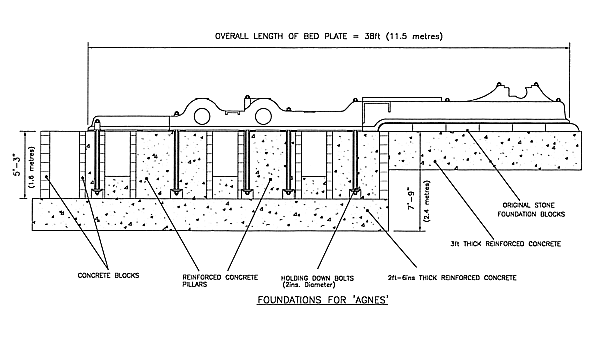
The mill is a listed building so that when the doorway, at the end, was removed to get the larger pieces out, it had to be replaced exactly as it was.
|
|
||
|
|
||
The Rescue
Agnes ran the machinery in the woollen mill at Washpit Mill, Holmfirth for over 70 years. She finished working on 16th January 1980, as did Herbert White the engine man.
At this point Tom Nuttall became involved, the outcome being that the directors of the mill, Brian and Ann Priest, kindly donated Agnes to the museum. A team from Markham Grange Nursery began removing the engine to add to Tom's growing collection. It proved to be a difficult task working under cramped and sometimes unpleasant conditions. Particularly under the bedplates, where a 1ft thick layer of grease and oil had accumulated over the years. The removal was completed in approximately 8 weeks, by July 1998, and transported back to the nursery for storage. Before removal from the enginehouse, at Washpit Mill, careful measurements and photos had been taken and all parts were marked and labelled to make rebuilding easier. |
||

|
Removing the air pump.
The mill is a listed building so that when the doorway, at the end, was removed to get the larger pieces out, it had to be replaced exactly as it was. |
|
Lifting the cylinder casting.
The heating pipes, on the right hand wall, are now helping to keep the workshop, at the museum, warm. |

|

|
Removing the connecting rod and cross-head assembly. |
|
With very little head room to work in, the first section of the flywheel is lifted clear.
The lifting beam had to specially made and installed before dismantling could take place. |

|

|
The last flywheel spoke about to be removed.
The wall on the right separated the flywheel from the engine room. |
|
|
The Rebuilding
When I started as a volunteer in Sept. 1998, the large castings were stored under tarpaulins in the yard, with the more vulnerable parts stored in the boiler house.
It was at this time that one or two more volunteers had come forward, bringing a variety of skills and expertise to help rebuild Agnes and develop the museum. Literally, hundreds of parts were degreased, cleaned and examined for wear and defects. Large items like the flywheel segments and spokes were shot blasted before being painted with primer.
Although not back to her full glory, Agnes was run under steam on 20th Oct. 1999, just 12 months since rebuilding started. A remarkable achievement by museum staff and volunteers alike. |
|
Excavating for the foundations.
In the foreground is the concrete base for the flywheel pit. |

|

|
The engine bed plates are already levelled on their foundations.
The space at the end is for the air pump bed plate. |
|
The crankshaft, with the flywheel hub attached, is carefully lowered into its bearings.
The alignment of the bearings was spot on! |

|

|
Fitting the spokes into the flywheel hub.
This was a tricky operation trying to keep the rotating mass balanced. |
|
Fitting the LP cylinder cover onto the ring of studs.
On the left is the air pump piston, sticking out of its end cover, waiting to be fitted.
|

|

|
On Wednesday 20th October 1999, Agnes was running on steam for the first time since 1992.
A good job well done! The 'A' Team celebrating with a glass of bubbly. |

|
|